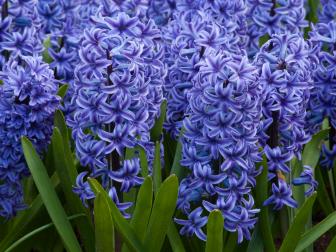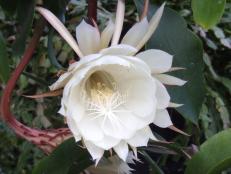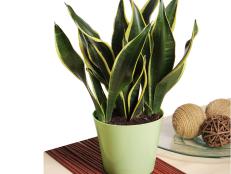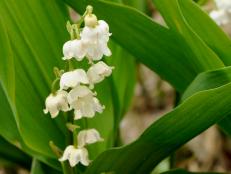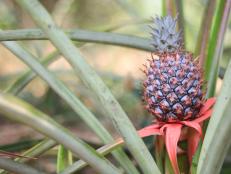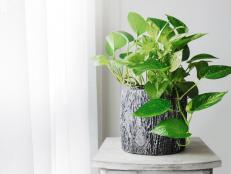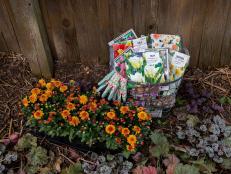How to Grow Caladium Plants
With its heart-shaped leaves, strong tolerance for shade and unique, tropical look, it’s no wonder gardeners love growing this summer bulb. Plus, caladiums are also an easy-care houseplant.

Caladiums are a favorite for containers and shade gardens. Plus, thanks to new hybrids in recent years, several options are also available for sunny conditions. You won’t find blooms on this garden favorite, but the colorful foliage more than makes up for it. The biggest challenge you’ll have is deciding how many different varieties to grow.

Bayu Widhi Nugroho
Easy-to-grow caladiums are available in a variety of colors and patterns.
In This Article
What are Caladiums?
Caladiums are tropical plants known for their striking leaves. They come in a wide range of colors and patterns, including vibrant splashes of red, pink, white and green. They thrive in both shade and partial sun, depending on the variety. Commonly used in containers, hanging baskets and shade gardens, caladiums are relatively easy to care for, asking only for moist, well-drained soil and regular watering to keep their stunning leaves bright and healthy throughout the growing season.
History of Caladiums
Caladiums are native to South America and were brought to the attention of European and North American gardeners in the 19th century. They quickly gained popularity for their colorful leaves and adaptability to indoor environments. Over the years, horticulturists have developed a wide variety of hybrids, from leaf shapes, sizes and color combinations. Gardeners around the world love caladiums because they instantly add a tropical look and feel anywhere they’re planted.
Varieties and Colors of Caladiums
There are more than 1,000 named cultivars of caladiums. The leaves can be pink, red, white, green, purple or a mix of all of these. They often have unique patterns, including speckles, stripes and distinct or contrasting borders. Some popular varieties include:
- 'Florida Sweetheart': Radiant pink leaves with green edges.
- 'Moonlight': Creamy white leaves that almost glow with a subtle green veining.
- 'Red Flash': Dark green leaves splashed with vibrant red and highlighted with pink spots.
- 'White Queen': Dramatic white leaves veined in green and flushed with pink.
These are just a small sample of the different varieties available. As you search for and find ones that appeal to you, just be sure to check the light needs and plant accordingly.
Ideal Growing Conditions for Caladiums
Best Soil Conditions and pH
Caladiums thrive best in well-draining, peaty soil that holds moisture without becoming waterlogged. Aim for a soil pH that is slightly acidic, typically between 5.5 and 6.5. This pH range helps caladiums absorb nutrients effectively, promoting vibrant, healthy growth. You can also do your part to help them by regularly adding in organic matter. This will go a long way to getting the ultimate color.

Proven Winners
Caladium Hortulanum Heart-to-Heart/Dawn-to-Dusk
Sunlight Requirements
Caladiums can thrive in both full shade to partial sun (check the variety), but they prefer bright, indirect light to avoid leaf scorch. Ideal planting spots are under trees or in areas where they receive filtered sunlight, mimicking their native tropical habitats. They also excel in containers, allowing for flexible placement around shaded patios or decks.
Watering and Fertilization Tips
These plants prefer consistently moist soil, so water them regularly to keep the soil from drying out, especially in warmer weather. However, avoid too much water as this can lead to root rot. A good rule of thumb is to water when the top inch of soil feels dry to the touch. For fertilization, caladiums benefit from a balanced, water-soluble fertilizer applied every four to six weeks during the growing season. This regular feeding supports their lush leaf production.
Pruning Caladiums
To maintain healthy caladiums, regularly inspect and prune any yellowing, brown or damaged leaves using scissors or pruning shears. Simply cut close to the base of the leaf stem. After the growing season, as the plants enter dormancy, trim back all foliage to just above the soil line. This selective pruning helps improve air circulation and light penetration, keeping the plants vibrant.
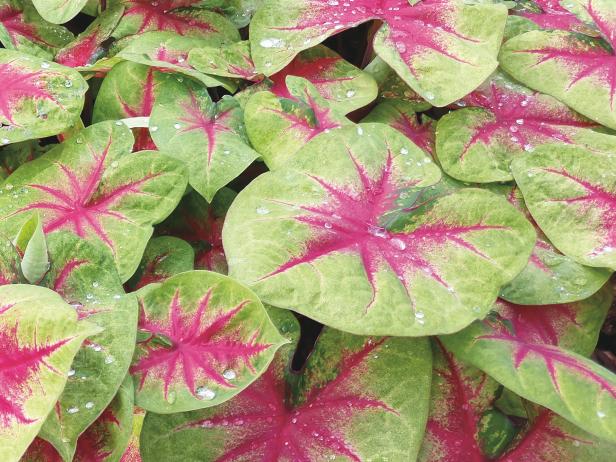
Proven Winners
Caladium Hortulanum Heart-to-Heart/Lemon-Blush
Pest Control Methods
To effectively control pests on caladiums, inspect plants for early signs of aphids, spider mites and mealybugs, especially under leaves and along stems. Treat infestations with neem oil or insecticidal soap, applying thoroughly to coat affected areas and disrupt pest life cycles. Additionally, isolate any new plants that show pest symptoms to prevent spread. These should help you keep your plants healthy.
How to Use Neem Oil on Plants
Neem oil helps control pests on garden and indoor plants. Learn tips for using this effective organic product.
Preventing Common Diseases
To prevent and treat common diseases in caladiums, use well-draining soil and only water when the soil's top inch is dry to avoid root rot. Promote good air circulation and prevent fungal infections by spacing plants properly. At the first sign of any disease, apply fungicides. You can also do your part to help by maintaining overall cleanliness and keeping your garden tools sanitized. One final thing you can do is to refresh your potting soil every year and/or practice crop rotation in your garden soil.
How to Plant Caladium Bulbs
To plant caladium bulbs, choose a location with well-draining soil and partial shade, ideally where they'll receive indirect sunlight. Plant the bulbs in spring when the soil has warmed up, about 2 inches deep with the knobby side (the eye) facing up. Space them about 8 to 12 inches apart to give each plant enough room to grow. (You can also plan for about three bulbs per container or more depending on the size.) Water thoroughly after planting to settle the soil around the bulbs. Maintain consistent moisture throughout the growing season and apply a layer of mulch to help retain soil moisture and keep the roots cool. This will encourage vibrant leaf growth and a healthy display of foliage.
Propagation of Caladiums
To successfully propagate caladiums, carefully dig up the tubers and clean off the soil. You can divide them or save them. When ready to grow in a new area, plant the prepared pieces in moist, well-draining soil, about 2 inches deep, with the eyes facing upwards. Keep the soil consistently moist and warm to encourage growth.
Dividing and Transplanting Caladiums
For division, separate the tubers ensuring each section has at least one growing point, or "eye." If cutting, slice larger tubers into pieces with a clean, sharp knife; each piece must have at least one eye. Treat the cut surfaces with a fungicide to prevent rot and let them dry for a few days. Then you can either store until it’s time to plant again or transplant to a garden bed or container right away.

Monchai Khudkhum
How to Create Stunning Displays
For the best look, focus on selecting a variety of colors and patterns that complement each other. Plant caladiums in groups for visual impact, using lighter colors in shady areas to brighten them up and deeper, vibrant colors to add depth and contrast. Consider their height and leaf size for layering, place taller varieties in the back and shorter ones in front. You can also incorporate them into borders, as under-plantings for taller, shade-loving shrubs or in containers to enhance patios and balconies.
Planting Caladiums in Containers and Baskets
Choose containers that complement the striking colors of caladium leaves. Make sure the containers have good drainage to avoid soggy roots. Mix caladiums with other plants that require similar light and water conditions, such as impatiens, ferns or begonias to create a beautiful display. In hanging baskets, position caladiums towards the center to allow room for their foliage to grow and spill over.
Companion Planting for Caladiums
Mix caladiums with other shade-tolerant plants that have contrasting textures, such as ferns and hostas, to enrich the overall composition. Properly planning the layout and combinations can turn an ordinary space into a vivid tapestry of colors and shapes throughout the growing season.
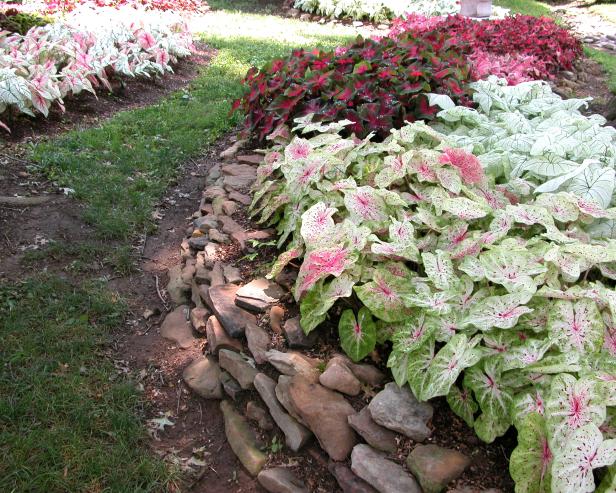
Marie Hofer
Mix different colors of caladiums to create a stunning display in a shade garden.
How to Overwinter Caladium Bulbs
Preparing Caladiums for Winter Dormancy
As temperatures drop, reduce watering to encourage the plants to die back naturally. Once the foliage has yellowed and died, cut it back to just above the soil line. If you’re in a zone with colder winters, carefully dig up the tubers and brush off the soil without washing them. Allow the tubers to dry in a cool place for about a week.
Storing Caladium Bulbs
Store these dried tubers in a breathable container filled with peat moss, vermiculite, or sawdust. Keep them in a cool (50-60 degrees Fahrenheit), dry area like a basement that doesn’t freeze. Check periodically for any signs of rot or excessive drying out during their dormancy. Then they’ll be ready to plant again in spring.
Replanting and Rejuvenating Caladiums in Spring
When it’s time to plant again, inspect the bulbs and discard any that have rotted or dried out. Follow the regular planting guidelines, ensuring to water thoroughly after planting to settle the soil around the bulbs. Maintain consistent moisture as they begin to grow.
Growing Caladiums as Houseplants
If you’re not ready to say goodbye to your caladium after the growing season, bring the plant inside and place it in a spot that gets bright indirect sunlight. Avoid direct sunlight as it can scorch the leaves. Caladiums are tropical plants so be sure to supply them some humidity. Fertilize once a month with a water-soluble fertilizer.
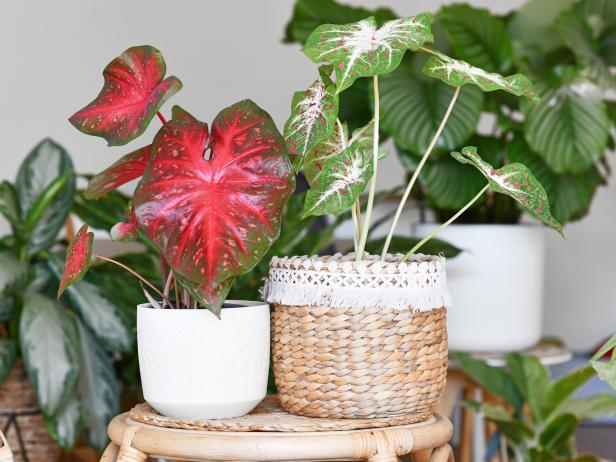
Firn
Multicolored exotic 'Caladium Red Flash' and 'Caladium Hearts Desire' houseplants.

.-Battle-on-the-Beach-courtesy-of-HGTV.-.jpg.rend.hgtvcom.196.196.suffix/1714761529029.jpeg)





